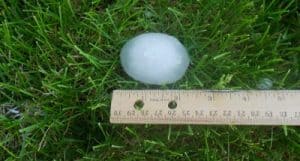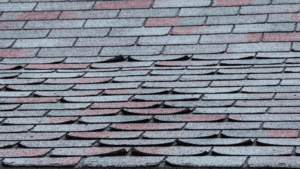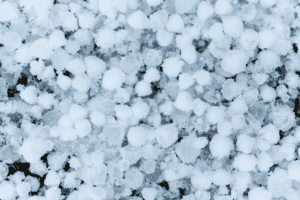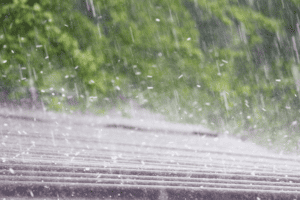The arrival of spring is a happy occasion, as the days grow longer and warmer, and the rains bring all the flora to vibrant life. But as every Denver resident knows, those April showers also have a dark side: hail storms. Depending on who you ask, Denver’s hail storm season lasts from mid-April until sometime around mid-August or mid-September. In particularly bad years, though, those four or five months can feel like years as storm after storm pummels the homes and livelihoods of folks across the Front Range. That’s because Denver lies within what meteorologists call “hail alley,” an area of the U.S. that sees more hail storms than any other.
But why does this happen? How costly are Denver’s frequent hail storms? And what can Denverites do to keep their families, their homes, and their livelihoods safe? At Elite Roofing & Solar in Denver, a significant part of our work involves inspecting, repairing, and even replacing roofs that have been severely damaged by Denver’s all-too-common hail storms. Because we’re so familiar with the incredible destruction caused by these storms, we’ve decided to put together a complete guide to Denver’s hail storm season to help our readers understand these powerful forces of nature—and how to prepare for them. Let’s get started!
Hail storms and the Front Range: A perfect storm
To understand why Denver and the rest of Hail Alley see so much hail, it’s important to understand both what hail is and how it forms. At the most fundamental level, hail is ice that falls to the ground as precipitation. Hail forms inside severe thunderstorms due to updrafts, as raindrops are forced to higher altitudes where the temperature is much colder, causing the droplets to freeze into ice. These pieces of ice then collide with other droplets of rain, which freeze onto the fledgling hailstones and cause them to grow larger. When the hailstones are too heavy for the updrafts to support, either because the updraft becomes weaker or the hailstones grow larger, they fall to the ground as hail.
Hail formation is not necessarily uncommon. Many severe storms have updrafts that blow raindrops such that they freeze. However, oftentimes hail melts before reaching the ground. This can happen either due to warmer air temperatures closer to the ground or because the hailstones have so far to fall. A combination of these factors explains why Florida tends not to have many hail storms despite having the most thunderstorm-prone cities of any state. Florida is relatively low-lying and warm, meaning that while severe thunderstorms are quite common, hail has far to fall in warmer temperatures before reaching the ground.
This is why Denver sees damaging hail storms so often. To reach the Mile High City, hail has much less farther to fall and less time to melt into rain—we are, after all, as much as a mile closer to the hail here in Denver. In addition, mountain ranges see updrafts much more commonly, acting as an elevated heat source that pulls warm air up into the atmosphere. In other words, the high elevation paired with the nearby Rocky Mountains are a perfect storm for hail production—a storm with Denver and the rest of hail alley caught smack-dab in the center.
How do hail storms affect humans?
When it gets down to it, severe hail can have many negative effects on humans. However, that human cost usually doesn’t come in the form of a death toll. If you’re thinking “Can a hail storm kill you?,” you can find some solace knowing that deaths from being struck by hail are incredibly rare. The last hail-related death in Colorado occurred in 1979, while the most recent hail fatality in the United States overall was in 2000. Hail storms can certainly kill animals, however, and humans have been injured by hail often enough. For instance, a 2018 hail storm injured 14 people and killed five animals at Cheyenne Mountain Zoo, near Colorado Springs.
Rather than looking at these storms in terms of casualties, however, the negative effects of hail are more commonly framed in terms of the damage done to homes and livelihoods. Hail storms commonly destroy crops and, yes, kill livestock caught out in the open, a tragedy that also severely harms the economic situations of farmers. And as we know all too well at Elite Roofing & Solar in Denver, Denver’s brutal hail storms can cause severe damage to the roofs of homes and businesses throughout the area. Hail damage to properties and vehicles in the Denver metro has been measured in the billions for particularly destructive storms, such as the May 2017 tempest that caused upwards of $2.3 billion in damages.
The worst storm in American history was in Denver in 1990! the damages report were $600 million. Adjusted in today’s dollars, the same storm would have cost $1 billion in 2013.
How big can hail get?

Weather reports on hail use a variety of comparisons in describing the size of hail. You might see minor hail storms produce “pea-sized” hail, while some of the more destructive storms on record have pelted areas with hail “the size of golf balls.” The National Weather Service even has a complete hail size chart, with comparisons to peas and marbles all the way up to grapefruits and softballs.
The largest hailstone ever recorded in the United States fell in Vivian, South Dakota, a hailstone that was nearly 8 inches in diameter. But with larger comparisons easily imaginable—like dodgeballs, basketballs, and beach balls—is this the upper limit? It’s difficult to say what the largest possible hailstone could be, especially with factors like climate change to consider. Some have theorized that climate change could result in fewer, but more severe hail storms, which could certainly break the above record. The important takeaway, though, is that hail can be quite variable, and it’s best to err on the side of caution when hail might be headed for your city.
Can we predict hail storms?
When listening to weather forecasts, you may have identified a pattern with reporting on hail. Weather reports and news broadcasts tend to say that storms “could produce hail,” rather than offering more definitive information on how likely hail is to fall and how severe it could be. According to the National Severe Storms Laboratory (NSSL), this is because “There is no clear distinction between storms that do and do not produce hailstones.” In fact, “Nearly all severe thunderstorms probably produce hail aloft,” but as noted in the previous section, hail often melts before striking the ground and causing damage.
Even so, there is a great deal of research currently studying how to better predict the likelihood of hail storms, as well as other factors such as the size of hail. The NSSL, for example, has worked on a technology called dual-polarization radar, which aims to better identify different kinds of precipitation. Many different research groups, including at the NSSL and other meteorology institutes, have formulated algorithms to aid forecasters in predicting hail. The Department of Atmospheric and Oceanic Sciences at UC Boulder even has a project called CHAT dedicated to tracking and predicting hail accumulation—an unfortunately real and surprisingly common phenomenon that may have you breaking out your snow shovel in the spring and summer.
Even with these research efforts, however, hail remains difficult to predict, especially as to where it will fall. Hail tends to fall along relatively narrow swaths, similar to the path of a tornado. Because of this, the best advice may actually be to react to hail the way we do to potential tornadoes. After all, tornadoes are incredibly destructive, yet hard to predict in terms of where they’ll touch down—if they do at all. Thus for hail and tornadoes alike, it’s a good idea to pay attention to forecasts describing storms that could produce either of these weather events and prepare accordingly.
Preparing for hail storms
As readers well know, there’s really no way to avoid being affected by Denver’s frequent hail storms. Short of picking up and moving, these weather events are simply a fact of life—but that doesn’t mean Denver residents are helpless. There are several actions home and business owners can take to prepare for these storms and minimize the out-of-pocket costs incurred by hail damage.
Long before: Insurance coverage
One of the most essential ways to prepare ahead of time is through insurance coverage. For any Denver resident, it’s critical to make sure your home or business is covered by a policy that includes coverage for hail damage. You wouldn’t be alone in getting hail insurance, not by a long shot; Colorado is second only to Texas—a state more than twice its size—in terms of hail damage claims. And while insurance does carry a cost, hail damage is practically inevitable in Denver. Insurance coverage can help farmers recover crop losses, drivers recoup expenses from vehicle damage, and homeowners pay for a roof repair, costs that might otherwise drain a large portion of your savings or necessitate a loan.
As the storm strikes: Seek shelter and keep an eye on forecasts
As for more in-the-moment preparations, you may feel like the only thing you can do is hunker down when hail storms are predicted in your area. And it’s certainly true that you should stay indoors, as one of the reasons hail-related injuries have declined over the years is because meteorologists are able to warn people early on. If the hail storm is still a ways off, bring any outdoor machinery, vehicles, or appliances to a sheltered area. Be sure to park your car in a garage or carport, if you have one. Keep children and pets indoors and away from windows.
But besides these safety precautions, it’s also important to pay close attention to hail-related weather updates. This is because meteorologists will often describe the hail in terms of its size, color, or even its destructive capabilities. Large, clear-colored hailstones generally cause more damage than smaller, cloudier ones. If your local weather station describes the hail as pea-sized and cloudy, you likely won’t have to worry about damage to your roof or home. If the hail is larger or denser (and thus clear in color), be prepared to assess any damage to your home promptly.
Hail storms: What to do after the fact
After a hail storm passes, the clock starts ticking. This is because insurance claims for hail damage must typically be filed within a certain window of time. That makes paying attention to the destructive capabilities of the hail storm all the more important; if you know the hail was likely to damage your roof, a roof inspection becomes very necessary.
You can do a cursory visual inspection of your roof from the ground before calling in a professional roofer. First, look for any pieces of roofing that have fallen to the ground. This could include things such as shingles, chunks of tile, or pieces of flashing. Broken pieces of roofing material are the clearest evidence of damage to your roof. Next, you can look for more circumstantial evidence of damage. For example, take a look at other portions of your home’s exterior. If you find dented gutters, broken siding, and damaged decks or fencing, it’s very likely that your roof has sustained damage as well.
In doing this cursory inspection, it’s very important to stay off your roof. While walking on your roof is never a good idea at the best of times, it’s even more risky when your roof has just been hit by a hail storm. Walking around could worsen existing damage to your roof, and it’s generally best left to the experts. If you note any signs of hail damage to your roof, it’s important to schedule a professional inspection promptly. Even if you don’t notice damage, it’s good to err on the side of caution, as an experienced roofer will be able to identify signs that you may have missed.
Elite Roofing & Solar Offers Free Hail Damage Inspections
Hail storms can be a stressful time. These damaging weather events can put families and livelihoods at risk, and that risk is even greater here in Denver because of our hail alley location. The Elite Roofing & Solar team is locally based, so we personally understand just how scary it can be to know your roof may be damaged. That’s why we offer free roof inspections after hail storms: to give folks the peace of mind that comes with knowing exactly what’s happened to their roof and how to make it good as new again. If you think your roof has been damaged by recent hail storms, or if you want to make sure it’s ready for the Denver hail storm season, contact us today for a free inspection!









